Want To Eat Like an Aristocrat? Grow It Yourself, Make It Yourself
April 7, 2016
Today's foodie culture is characterized by End of the Empire over-the-top excess.
We are constantly hectored to eat well, but what does this mean? Does it mean to eat more like wealthy elites, or to eat healthier food?
Actually, these two are equivalent: the Aristocracy eats much healthier than the bottom 95%, most of whom are gaining weight and acquiring the resulting chronic illnesses: The World Is Getting Fatter and No One Knows How to Stop It.
It's not by chance that the Chinese political Elites maintain organic farms to grow the food they consume, nor is it chance that slim, fit people tend to be wealthy: they have the time and money to eat well, maintain a fitness regime, etc.
So what's the secret to eating like the Aristocracy on a peasant budget? Grow it yourself, make it yourself. Take control of your food source, prepare your own meals with real ingredients and eat sparingly.
Today's foodie culture is characterized by End of the Empire over-the-top excess: dishes are absurdly complicated, and exotic ingredients and novel combinations are de rigueur (required by current fashion). While portions are small at the top of the foodie pyramid, portions are huge in the lower 95% of the prepared food universe.
When sodas were a luxury, the bottles held less than 12 ounces of liquid sugar. Now soda servings at fast-food outlets are so excessive, each container is enough for 6 people--but one person consumes it all.
Both the refinement and the cost of restaurant food are levitating to truly insane heights: people slavishly line up to buy a trendy chef's bowl of ramen noodles--once a cheap lunch--for $20 a pop, gladly pay $3.25 for a tiny little doughnut with a special glaze, and fork over $100 per diner as The New Normal at chic bistros.
Nice--if you have an Aristocratic budget. Most people don't, so the solution is to eat like an Aristocrat but on a peasant's budget.
Dessert should be a rarity, but when you do want a fancy dessert, make it yourself, preferably with fruit you grow yourself.
Here is a snapshot of a lemon-meringue pie we brought to a friend's dinner party:

The lemons were plucked from our tree an hour before their juice and zest went into the pie filling. Making pie crusts from scratch is a tedious process, so we always make a batch and freeze the extras. This saves time when you decide to make a pie.
Complicated desserts and dishes are easier with a team effort; my modest contribution was whipping up the meringue to the right peak, and our young friend applied the meringue topping to the lemon filling.
Here's a simple lunch using potatoes and lettuce leaves from our garden. Most people eat a whole salmon/veggie burger without a thought, but a half is enough unless you're doing heavy work.
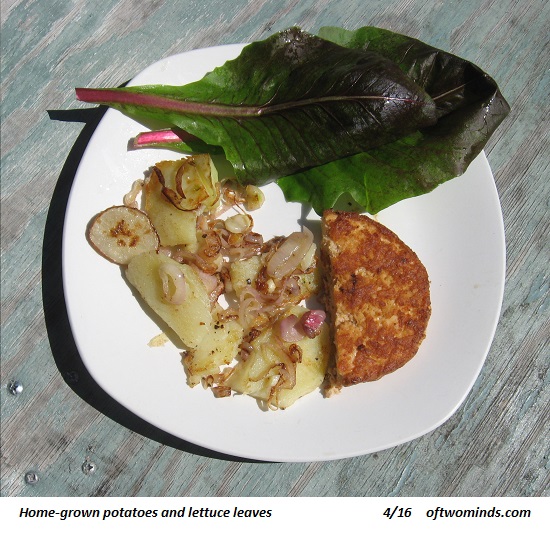
Using real ingredients (as opposed to packaged stuff) is the core to eating well. The Aristocracy don't eat out of the supermarket freezer or out of a tray/bag of factory-glop. Having the right seasonings and sauces (which cost very little and last a long time) is also key.
For day-to-day cooking (i.e. not a dinner party for guests), I often turn out an Asian-style stir-fry, which is highly flexible in terms of ingredients. If you're unfamiliar with Asian vegetables, here's a brief primer: A Visual Guide to 10 Varieties of Asian Greens.
You need access to an Asian grocery to buy these, but conventional veggies such as broccoli and mushrooms can easily be substituted for the various choys (leafy greens).
Stir-fries are also highly flexible in terms of meat or meat substitutes. Meat (or tofu-based substitutes) is used sparingly in Asian stir-fries; meat is a condiment, not the dominant ingredient. When we BBQ, the leftover meat is sliced up (a few ounces is enough) for stir-fries.
As for all the usual complaints about real food being too expensive: use meat sparingly, don't waste a single bite of what you prepare and eat less--a lot less. Americans, rich, poor and everyone in between throw out 40% of their food. As for poor people not having time to cook, or not having a well-equipped kitchen: I work 12-hour days, and it's faster for me to cook a stir-fry than it is to get in my car and drive to a fast-food outlet.
The vast majority of Indian and Chinese/Asian dishes require a single burner and a single wok or pan--a propane camp stove is more than adequate.
The reality is it's cheaper to eat real food than packaged rubbish if you make an effort to shop carefully, maintain a garden (or sign up for a community garden), don't waste a single ounce of real food, use meat and costly ingredients sparingly, and eat sparingly. We've become a culture of excuses rather than solutions: solutions always require sustained effort and discipline. Garbage in, garbage out: make no effort, reap no benefits.
Meat is expensive, so only use a few ounces of it. Substitute cheaper seasonal veggies for whatever is expensive, and search through the bargain bin. Go to ethnic markets/ halals for better prices and fresher produce.
The trick to stir-fry is to work with the fact that different ingredients cook at different rates. Start by frying up onions, garlic and the meat or substitute. In this case, I used a chili bean sauce as the foundational flavor; other options include black beans. Cook this up and then set it aside.
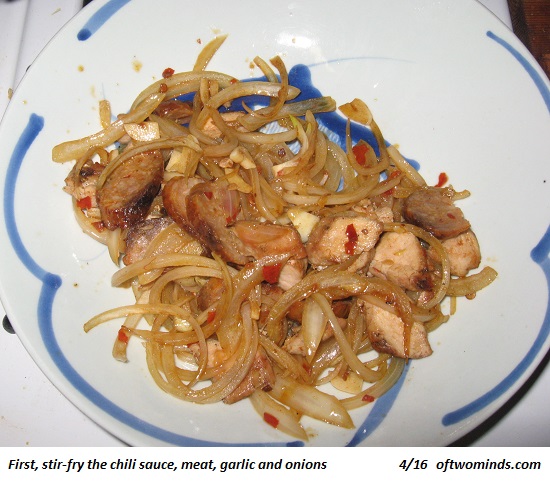
Here are a few of the key flavorings; not shown are fish sauce and oyster sauce.
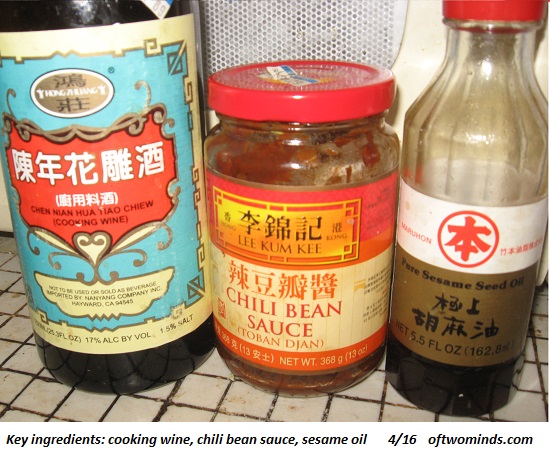
This is choy sum, which is very similar to yau choy (same family). I add a few drops of fish sauce for light saltiness (not too much salt, that ruins the dish). Always use a good quality cold-pressed oil; a little goes a long way. If the veggies need a bit of liquid, add a few teaspoons of the Chinese cooking wine.
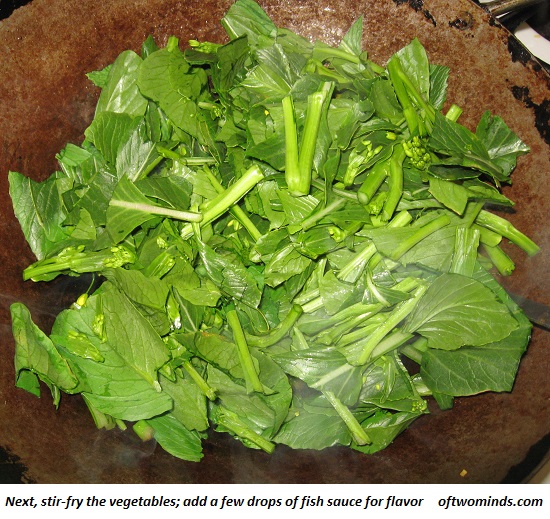
When the veggies are done (but not overdone--practice makes perfect), fold in the onions/meat with a tablespoon of oyster sauce, which adds a faint sweetness to the spiciness of the chili sauce. (The ideal is a balanced mix of salty, sweet, spicy and savory.)
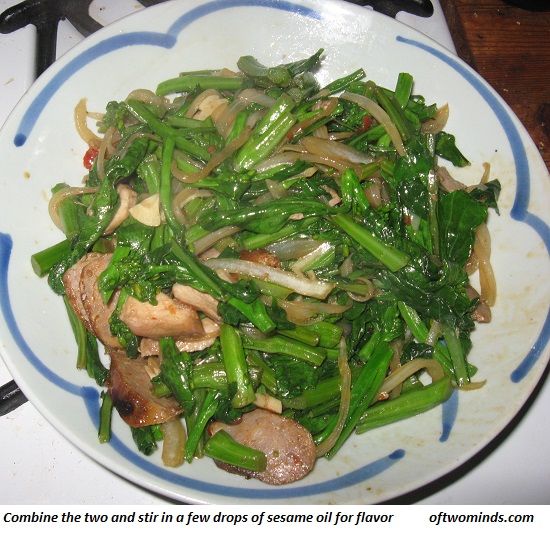
This is not a super-refined dish that takes hours to prepare; it is designed for overworked, over-scheduled, semi-exhausted people who want a healthy homecooked meal in 20 minutes.
This goes well with a small portion of rice or other carb of choice--or with other veggie dishes if you are avoiding carbs.
Combine this with a toxin-free garden with good soil, a good night's sleep, a fitness program that works for you, and you're living the Aristocrat life on a peasant budget.
"A healthy homecooked family meal and a home garden are revolutionary acts."
NOTE: Contributions/subscriptions are acknowledged in the order received. Your name and email remain confidential and will not be given to any other individual, company or agency.
|
Thank you, Tai Tois et Mange ($50), for your splendidly generous subscription to this site -- I am greatly honored by your steadfast support and readership. |
Thank you, Cheryl N. ($50), for your superbly generous contribution to this site -- I am greatly honored by your support and readership. |
Discover why Iím looking to retire in a SE Asia luxury resort for $1,200/month.